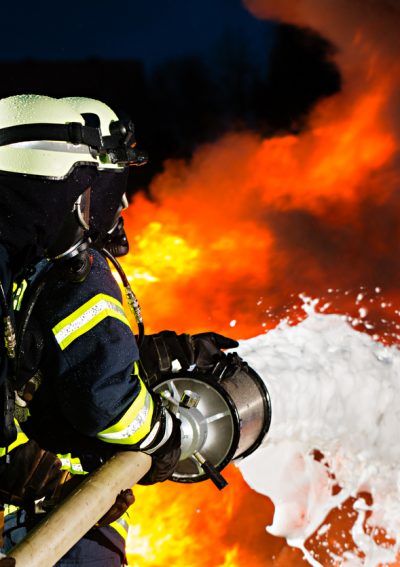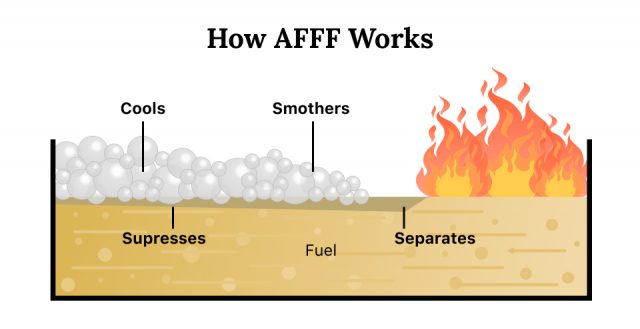Aqueous Film Forming Foam (AFFF)
Aqueous film forming foam, or AFFF, is a fire suppressant used to fight flammable liquid fires. Firefighting training facilities and vehicles, ships and shore facilities and military facilities are some of the places AFFF is used. Toxic chemicals in some AFFF solutions may increase the risk of serious health problems, including cancer.

AFFF contains water and other chemical components, including ethylene and propylene glycol which extend the life of the foam. The firefighting foam comes in a concentrate mixed with water. It’s available in three percent and six percent formulas, depending on how much water is in the mix.
Firefighters use AFFF to extinguish fires that are difficult to fight with water alone, especially those that involve flammable liquids, like petroleum.
In order to make the mixture foamy and create a film that helps extinguish fires, AFFF contains chemicals called per- and polyfluoroalkyl substances, or PFAS. Manufacturers have used PFAS in consumer and industrial products since the 1950s.
Two of the most common types of PFAS found in AFFF are perfluorooctane sulfonate (PFOS) and/or perfluorooctanoic acid (PFOA). These chemicals are human-made compounds that don’t occur naturally in the environment.
Firefighters spray AFFF onto a fire, and it works by coating the fuel behind the fire and by cooling the fire. It also covers the fuel in a film that prevents oxygen from reaching the fuel. This stops the fire from reigniting.

Is AFFF Toxic?
AFFF is toxic, especially if it contains PFOS and PFOA.
These PFAS are present in small amounts in the blood of most people in the United States, according to the U.S. Department of Veteran’s Affairs and the EPA. For most people, they don’t pose a threat in small amounts.
But they are harmful if a person suffers long-term exposure, according to the U.S. Fire Administration. The chemicals build up in the body and may cause negative health effects, including cancer.
Lab studies have found that PFOS and PFOA are toxic to animals. The U.S. Environmental Protection Agency found evidence suggesting that PFOS and PFOA may cause cancer.
Because of health and environmental concerns, some manufacturers agreed to phase out the production of PFOS in the United States starting in 2002. Other companies agreed to phase out production of PFOA and PFOA-related chemicals by 2015, according to the EPA.
The EPA issued a final guidance on its Significant New Use Rule (SNUR) regulating PFAS in January 2021. The rule prohibits companies from importing, manufacturing, using or processing certain long-chain PFAS without first letting the EPA review and approve it. This also applies to companies importing these chemicals when they are used as a surface coating.
Despite the EPA’s regulations, older AFFF stock may still contain these toxic chemicals.
Possible Exposures
Large companies such as 3M manufacture AFFF, and firefighters and military personnel have used these products for decades.
People who work directly with the foam may be at risk of long-term exposure and negative health effects. This includes current and former civilian or military firefighters.
Because these chemicals may leak into the environment and water, people who live near facilities that use AFFF — such as military facilities or chemical plants — are also at risk.
People who work with these chemicals and those who live near facilities that use PFAs have higher levels of the chemicals in their blood, according to the EPA.
- Aviation operations
- Chemical plants
- Fire departments and other municipal services
- Flammable liquid storage and processing facilities
- Highway emergency response
- Military facilities
- Oil refineries and bulk fuel storage facilities
- Oil tankers and offshore platforms
Illnesses Linked to AFFF Exposure
Some studies have reported health problems linked to the chemicals in AFFF, but researchers need more medical and scientific evidence to learn more about the risks to human health.
Not everyone will become sick after PFAS exposure. The risk of developing health problems depends on how often a person is exposed, the amount of chemicals they are exposed to and how long they have been exposed.
People with long-term exposure are most at risk.
- Asthma
- Changes in fetal and child development
- Changes in the immune system
- Cholesterol problems
- Fertility issues
- Increased risk of testicular, kidney and other cancers
- Liver damage
- Pregnancy-induced hypertension/preeclampsia
- Thyroid disease
- Ulcerative colitis
Litigation
People who were exposed to AFFF and developed cancer or other serious health problems are filing AFFF lawsuits against manufacturers, including 3M.
Civilian and military firefighters are some of the first people to sue after developing cancer and other conditions. Many of these firefighters have been using AFFF for years.
Lawsuits claim defendants knew or should have known that PFAS in AFFF are toxic carcinogens that can remain in the human body and cause health problems. They also failed to warn the public that exposure to AFFF containing PFAS was hazardous to human health.
7 Cited Research Articles
Consumernotice.org adheres to the highest ethical standards for content production and references only credible sources of information, including government reports, interviews with experts, highly regarded nonprofit organizations, peer-reviewed journals, court records and academic organizations. You can learn more about our dedication to relevance, accuracy and transparency by reading our editorial policy.
- International Agency for Research on Cancer. (2021). List of Classifications. Retrieved from https://monographs.iarc.who.int/list-of-classifications
- Lerner, A. (2018, February 10). The U.S. Military is Spending Millions to Replace Toxic Firefighting Foam with Toxic Firefighting Foam. Retrieved from https://theintercept.com/2018/02/10/firefighting-foam-afff-pfos-pfoa-epa/
- Sheinson, R.S. et al. (n.d.). The Future of Aqueous Film Forming Foam (AFFF): Performance Parameters And Requirements. Retrieved from https://www.nist.gov/system/files/documents/el/fire_research/R0201327.pdf
- State of Alaska Department of Environmental Conservation. (2021). Aqueous Film Forming Foam (AFFF). Retrieved from https://dec.alaska.gov/spar/csp/pfas/firefighting-foam/
- U.S. Department of Veterans Affairs. (n.d.). PFAS - Perfluoroalkyl and polyfluoroalkyl substances. Retrieved from https://www.publichealth.va.gov/exposures/pfas.asp
- United States Environmental Protection Agency. (2017). Technical Fact Sheet – Perfluorooctane Sulfonate (PFOS) and Perfluorooctanoic Acid (PFOA). Retrieved from https://www.epa.gov/sites/production/files/2017-12/documents/ffrrofactsheet_contaminants_pfos_pfoa_11-20-17_508_0.pdf
- United States Environmental Protection Agency. (2021, January 19). Compliance Guide for Imported Articles Containing Surface Coatings Subject to the Long-Chain Perfluoroalkyl Carboxylate and Perfluoroalkyl Sulfonate Chemical Substances Significant New Use Rule. Retrieved from https://web.archive.org/web/20210318080826/https://www.epa.gov/sites/production/files/2021-01/documents/final_lcpfac-snur_surface-coating-compliance-guide_0.pdf
Calling this number connects you with a Consumer Notice, LLC representative. We will direct you to one of our trusted legal partners for a free case review.
Consumer Notice, LLC's trusted legal partners support the organization's mission to keep people safe from dangerous drugs and medical devices. For more information, visit our partners page.
855-591-2107

